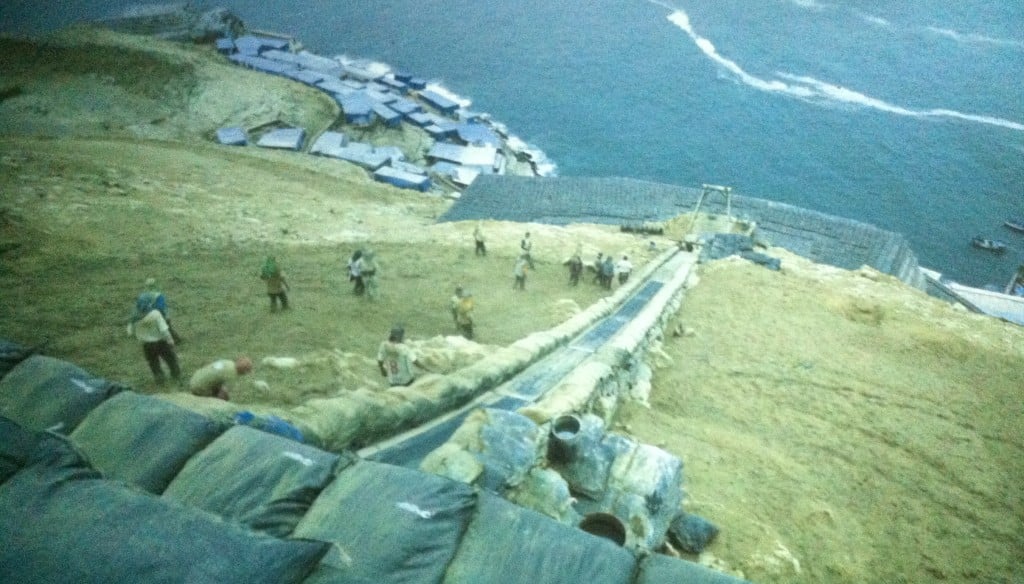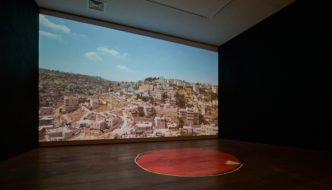Exhibition review: Dinh Q. Lê’s The Colony @ the IKON Gallery
March 7, 2016

Inhabiting the first of the IKON’s two main exhibition spaces, Vietnamese-American artist Dinh Q. Lê’s The Colony straddles the fault line between contemporary political commentary and hypnotic art film. Three projections and two flatscreen TVs placed somewhat precariously on the floor occupy this muted, dimly lit space. Imperialism, conflict over resources and ecological change all percolate in a blurred and contemplative context to create a unique and compelling installation.
Footage captured by drones drifting about the cliffs in lazy circles, sets a somewhat sinister tone, with the drone itself functioning as “an aggressor, a kind of alien of the future” in Lê’s own words. The Colony documents the continuing guano harvesting operation, now undertaken entirely by Peruvians.
Guano, in particular dried Peruvian Booby faeces, forms the principal indeed only export of the little-known Chincha Islands, situated thirteen miles off the coast of Peru. A potent fertiliser and source of ammonia derivative saltpeter for gunpowder, this lucrative commodity attracted the colonial interests of both Spain and the United States during the latter half of the Nineteenth Century.
At the height of guano extraction in the 1860s, a workforce of imported of Chinese “coolies” and locals toiled in harsh conditions to generate nearly sixty percent of Peru’s annual revenue. Occupied by Spanish marines during the Chincha Islands War of 1864-66 and indirectly claimed under the U.S Congress ratified Guano Islands Act, the Chincha Islands join the East Indies, Falklands and other remote places as targets of imperial acquisition.
The treeless barren outcroppings of the Chinchas, teeming with seabirds gathering in great flocks, are an eerie backdrop for the Lê’s discussion of contemporary Chinese expansionism within its own sphere of influence in the South China Sea. In his first piece not directly related to Vietnam, Lê nevertheless retains an acute awareness of reckless expansionism and geopolitical instability.
China’s creation of man-made islands, complete with cement factories, runways and barracks alarms the international community. America in particular, along with its satellites South Korea and Japan, watches with apprehension. One of the floor mounted screens shows a collision between Chinese and Vietnamese ships, highlighting the muscular projection of Chinese maritime power. The sailors shout fearfully, and we gaze on from their perspective, a charged experience.
The other video is shot from the interior of a United States naval surveillance aircraft, the Boeing P-8 Poseidon, which carries a suite of advanced avionics and cameras, capable of scrutinising Chinese activities in minute detail. Sedately cruising above the clouds, terse exchanges pass between the aircraft’s crew and Chinese military authorities over the legality of patrol and surveillance. The strategic importance of these waterways, and their abundance of fish, oil and natural create a dangerous intersection of military strategy and resource acquisition. The parallels with the Chinchas are clear.
As Lê’s drones surveil the Chinchas, these same instruments of future technowar are used to monitor the starkly beautiful flashpoint of the South China Sea. The viewer is invited to look on warily, and perhaps walk away with a sense of apprehension and unease. Will the South China Sea be scoured like the Chinchas, terraformed to brown nothingness by manmade landmasses?
For more on Dinh Q. Lê:
The Farmers and The Helicopters
Signalled From The Periphery Installation, Portland OR
Upcoming at the IKON: People’s Archive Weekend Stories of Balsall Heath, Saturday 12 and Sunday 13 March 12-4pm.
Filed under: Art & Photography, Politics
Tagged with: Booby, Guano, photography, Poverty, urban, Vietnam



Comments